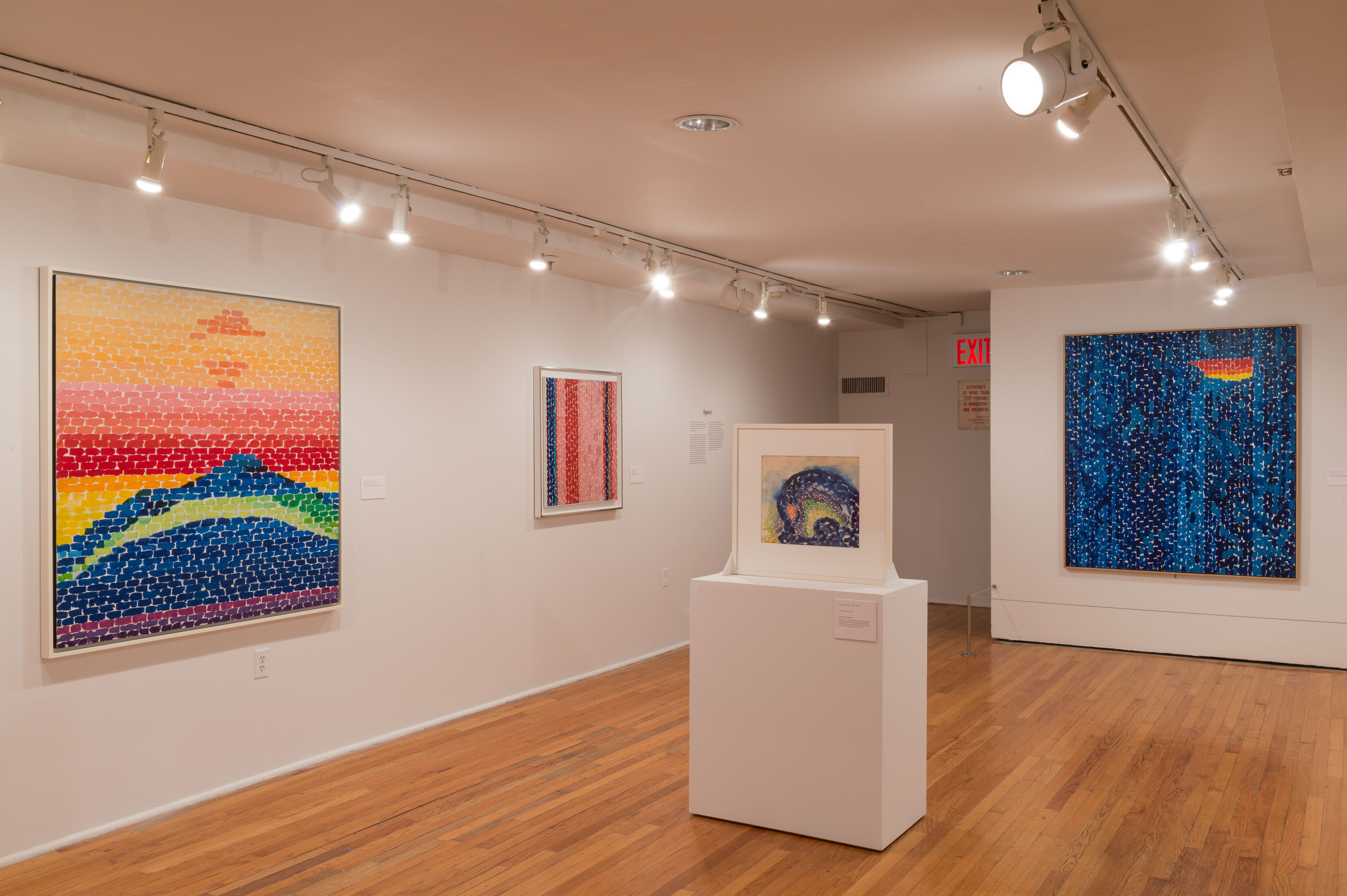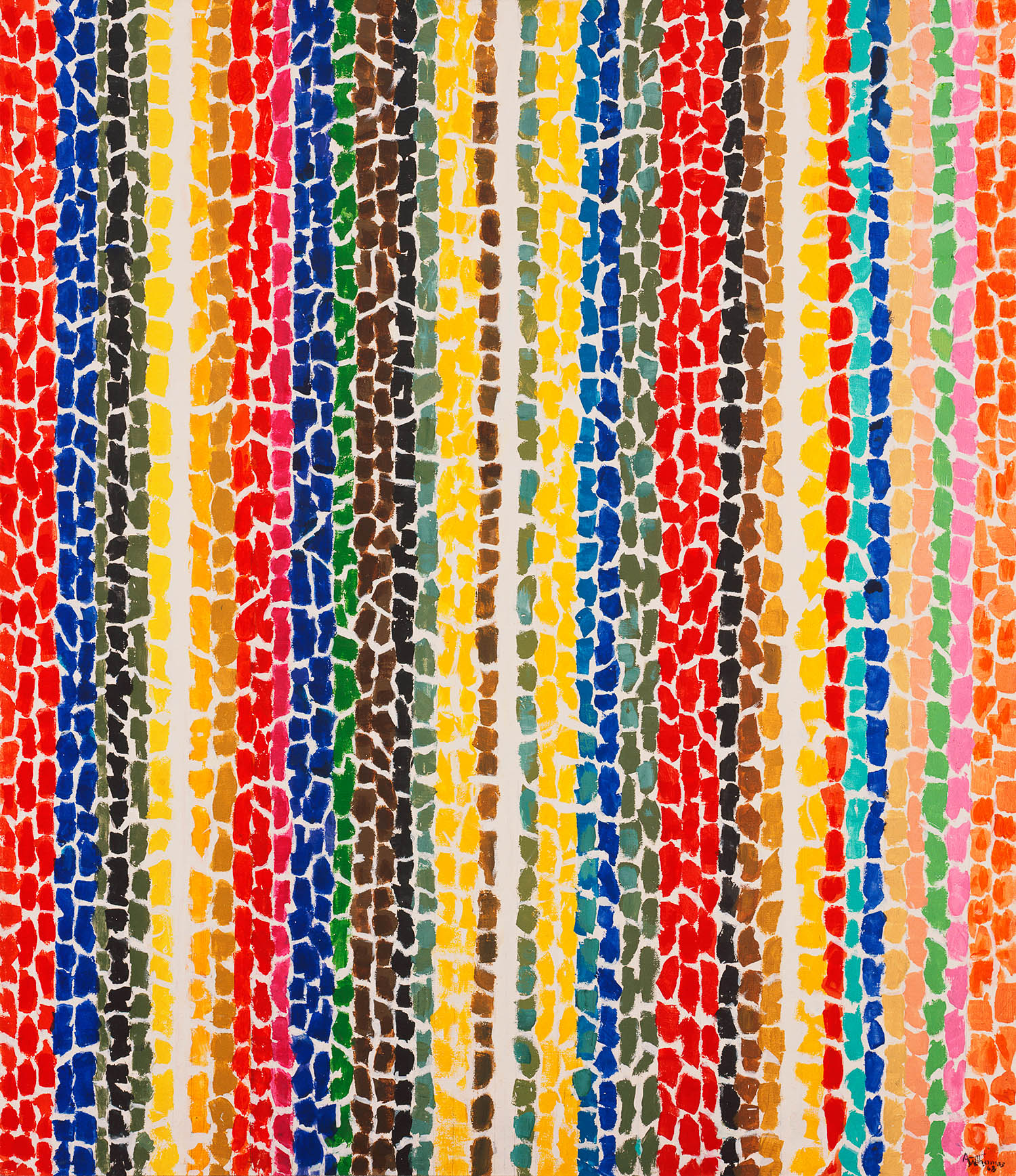 Aruna D’Souza
Aruna D’Souza

Alma Thomas (installation view). Photo: Adam Reich.
Alma Thomas, through October 30, 2016, The Studio Museum in Harlem, 144 West 125th Street, New York City, studiomuseum.org
• • •
The writer and activist Audre Lorde wrote that “Caring for myself is not self-indulgence. It is self-preservation, and that is an act of political warfare.” This sentiment was on display this summer, to great effect, in two connected events. The first was the establishment of the Black Women Artists for Black Lives Matter (BWA for BLM), a collective of over one hundred women of color spearheaded by Simone Leigh, which “focuses on the interdependence of care and action . . . in order to highlight and renounce pervasive conditions of racism.” The second was Leigh’s The Waiting Room, an exhibition at the New Museum that explored alternative models of healthcare for and by black women. Both were premised on the idea that when it comes to black bodies and black political resistance, care-taking—whether of self or community—is a radical act. Also this summer, a cannily curated survey of the mid-century abstract painter Alma Thomas opened at the Studio Museum in Harlem. A coincidence, to be sure—and yet the chance to see the Thomas show in light of these other happenings clears a space for re-thinking her practice.
Thomas began painting full time in 1960, after spending thirty-five years teaching junior high school in Washington, DC. She was sixty-nine. But the late start didn’t prevent her from being celebrated in the not-quite twenty years of her professional life as an artist, best known for large, dazzlingly colorful canvases made up of saturated, blocky strokes of acrylic on white ground. By 1966—just six years into Thomas’s retirement as a teacher—she was the subject of a major exhibition at Howard University. In 1972, at the age of eighty, she had a retrospective at the Corcoran Gallery of Art and a solo show at the Whitney Museum of American Art—the first by a black woman artist there. Jimmy Carter invited her to the White House in 1977. She passed away the following year.
The exhibition at the Studio Museum spans the period from the late 1950s—just before Thomas turned to painting full time—until her death. This was when she began working in the orbit of the Washington Color School painters, including Morris Louis, Kenneth Noland, and Gene Davis. It was also when the struggle for black civil rights became a defining—even unavoidable—feature of the American political landscape, both in moments of charged protest and those of provisional victory. The curators, Lauren Haynes from the Studio Museum and Ian Berry from the Tang Museum at Skidmore College, seem intent on bringing these two facts into closer proximity when it comes to Thomas’s work and encouraging us to reflect on her art’s multiple audiences.
Like her Washington Color School peers, Thomas was devoted to abstraction and animated by color. Following their patron saint, Helen Frankenthaler, Louis and Noland aimed to fuse pigment and canvas so that the picture became an uninterrupted, wholly two-dimensional surface, more akin to dyed fabric than anything. Thomas, for her part, was perfectly okay with the slightly sculptural appearance produced when she touched her loaded brush to the smooth white canvas. In fact, her brushstrokes seem to dance and flicker in front of the support rather than being fused to it.

Breeze Rustling Through Fall Flowers, 1968. Acrylic on canvas, 58 7/8 × 50 inches. The Phillips Collection, Washington DC. Photo: Arthur Evans.
Inspired by the experience of nature in her lovingly tended garden, the crayon-bright Breeze Rustling Through Fall Flowers and Wind, Sunshine and Flowers (both 1968) are simultaneously elegant and childlike—childlike in the manner of the early-twentieth century Fauve painters Henri Matisse and André Derain, that is to say, or the expressionist canvases of Wassily Kandinsky, all of whom were touchstones for Thomas. The white slivers that peek out between the colored strokes look rough-hewn and delicate by turns, the variable widths of the vertical stripes random and syncopated. The studied innocence of the paintings, a hallmark of the Euro-American modernist lineage to which Thomas belongs, is underlined by looking at the small works on paper presented in vitrines in the galleries, which include graphite and watercolor diagrams—plans for larger paintings—with color choices and underlying patterns devised in advance.
Thomas once said, “Through color, I have sought to concentrate on beauty and happiness, rather than on man’s inhumanity to man.” It would be easy to hear in her words an echo of Matisse’s infamous remark that he dreamed of making art that was “a soothing, calming influence on the mind, something like a good armchair” for a tired businessman: a palliative, an escape, a retreat into bourgeois complacency. But what this exhibition makes clear is that Thomas’s desire to concentrate on color, beauty, and even the anodyne state of happiness was of a different valence than Matisse’s.
It does so in part by hanging—at the start of a show otherwise filled with abstractions whose titles mostly refer to gardens, starry skies, or deep space—two small works by Thomas from 1964 depicting the previous year’s March on Washington. With their brushy renderings of faceless figures against a curtain of wordless placards, these are hardly radical political statements. And yet their mere presence, the only overt nods to either figuration or the black struggle for justice in the show (and among the few in Thomas’s career), inflects everything that comes after.
It forces us to ask, at the least, what the act of turning her attention to nature in the middle of a city divided by race and poverty might mean. Is painting pictures inspired by her garden a flight from politics when that garden belongs to the house Thomas moved into with her parents in 1907, in part to escape racial tensions in her native Georgia? Or when that house is in a city that was the first in the US to have an African-American majority and was a key site of civil rights activism?
Haynes writes that “Thomas pointedly rejected painting about struggle and crisis . . . Her goal was to create brief respites from many of the difficulties suffered by those who lived in her segregated neighborhood; she attempted to teach her viewers to find the wonder of nature in their own front yards.” The key idea here for me is “respite”—something quite different than escape. Respites are breaks from the action, not flights from them, and in this sense Thomas’s works seem less like apolitical retreats from the harsh realities of her political moment than (echoing the concerns of Simone Leigh) acts of nurturing and care for a community stretched to its limit. To say this another way: What may well have struck the white art world as comfortably void of any reminders of race politics could have operated quite differently for Thomas’s black audiences. While this exhibition doesn’t make the case fully, it does the extraordinary service of putting these ideas—and these paintings—into our range of vision at a historical moment that is witnessing its own (perpetual) struggle for black lives.
Aruna D’Souza writes about nineteenth, twentieth, and twenty-first-century art, as well as food, culture, diaspora, and feminism. Her essay “Dislocations: The Paintings of Toba Khedoori” will appear in Toba Khedoori (LACMA, 2016) this fall. She works at Bennington College.